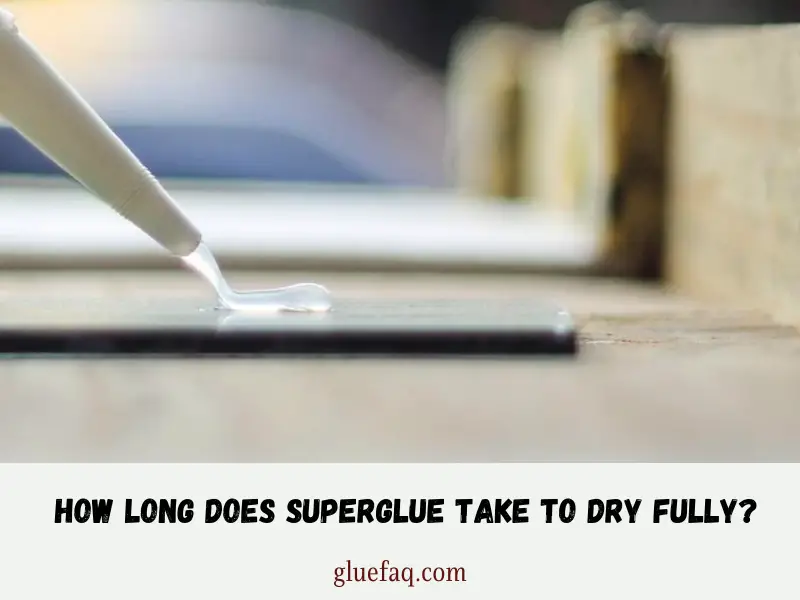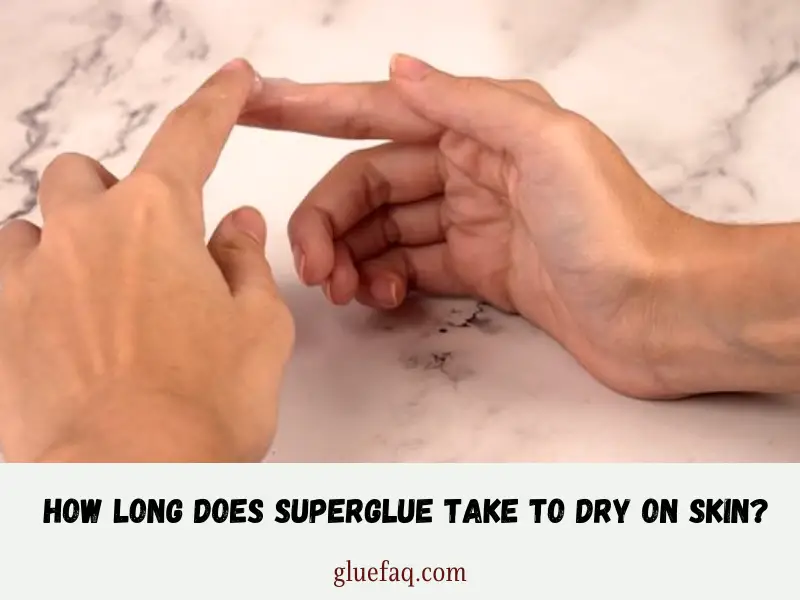Super glue, also known as cyanoacrylate adhesive, is a popular and versatile adhesive that bonds quickly and securely. Whether you’re working on a craft project, fixing household items, or even pursuing professional repairs, understanding the drying time of super glue is essential for achieving successful results.
In this article, we will explore the factors that affect the drying time of super glue, average drying times for different types of super glue, tips for faster drying, and situations where extended drying time may be necessary.

Super glue is a powerful adhesive that forms a strong bond between materials such as metal, plastic, wood, and ceramics. It offers a quick and efficient solution for bonding, making it a popular choice for many applications. However, the drying time of super glue can vary depending on several factors.
Factors Affecting Drying Time
- Type of Super Glue: Different types of super glue formulations have varying drying times. Instant adhesives, also known as cyanoacrylate adhesives, typically dry within seconds to a few minutes. Gel-based adhesives take slightly longer to dry compared to their liquid counterparts.
- Environmental Conditions: The surrounding environment plays a crucial role in the drying time of super glue. Higher humidity levels can slow down the drying process, while low humidity can accelerate it. Similarly, temperature affects the drying time, with warmer temperatures generally speeding up the process.
- Surfaces Being Bonded: The type and condition of the surfaces being bonded can influence drying time. Smooth and non-porous surfaces generally facilitate faster drying, whereas porous materials may absorb some of the adhesive, causing extended drying times.
Average Drying Time for Super Glue
- Instant Adhesives: Instant adhesives are renowned for their rapid bonding properties. They typically dry within seconds to a few minutes, allowing for quick and efficient repairs. However, it is crucial to ensure precise alignment of the bonded surfaces since adjustments become challenging once the glue sets.
- Gel-based Adhesives: Gel-based superglues offer a more controlled application due to their thicker consistency. They take slightly longer to dry compared to instant adhesives, usually within 10-30 seconds. The gel-like formula allows for better gap-filling capabilities, making it suitable for vertical surfaces and porous materials.
- Liquid-based Adhesives: Liquid-based superglues have a thinner consistency, facilitating easy application. They generally dry within 1-5 minutes, providing ample time for adjustments before the bond becomes permanent.
How Long Does Superglue Take to Dry Fully?
If you’re going to use super glue to repair something, you’ll want to know how long it takes for the adhesive to dry entirely. So, how much time will it take?
Superglue takes 24 hours to fully cure and reach its maximum adhesive strength. It may set in a few seconds, but it will take at least a day to properly dry.

If you touch superglue after only a few seconds, you will realize that you can still feel it on your fingers. This is because it will not have completely dried. It could have been set, but that is not the same as curing, often known as drying.
Read: How Strong is Super Glue and Baking Soda?
How Long Does Superglue Take to Dry on Skin?
When you’re using superglue, sometimes it can accidentally get on your skin. If this happens, you might start to worry and wonder how to get it off. But did you know that glue dries up differently when it falls on your skin compared to other surfaces?
Yes, it does dry up, but since your skin is not like hard materials such as wood, plastic, or glass, it can cause some trouble. If superglue accidentally lands on your skin, there’s no need to panic.
Just wait for a few days, and then you can wash it away using a special mixture of acetone and water. This mixture will help dissolve the superglue and make it disappear.

So remember, even if superglue gets on your skin, there’s a simple solution to remove it safely. Just be patient and follow the steps to wash it away with the special mixture. You’ll have clean skin again in no time!
Tips for Faster Drying
- Applying in Thin Layers: Applying super glue in thin layers promotes faster drying. Thick layers take longer to cure and may result in weaker bonds. Use a small amount of glue and spread it evenly across the surface to achieve optimal drying time and bond strength.
- Using Accelerators: Accelerators, also known as activators, are substances that expedite the drying process of superglue. They can be applied to one surface or both surfaces before bonding to decrease the drying time significantly. However, it’s essential to follow the manufacturer’s instructions when using accelerators.
- Increasing Temperature: Warm temperatures can accelerate the drying time of superglue. If feasible, consider placing the bonded objects in a warm environment or using a heat source (e.g., a hairdryer on low heat) to speed up the drying process. However, avoid excessive heat that may damage the materials or compromise the bond.
Extended Drying Time Scenarios
In certain situations, the drying time of super glue may be longer than average. Here are a few scenarios where extended drying time is common:
- Large Bond Areas: When bonding large surfaces, the drying time may increase due to the larger amount of glue applied. It’s crucial to exercise patience and allow sufficient time for the adhesive to cure fully.
- Porous Materials: Porous materials, such as fabric or wood, tend to absorb superglue, leading to slower drying times. The adhesive may penetrate deeper into the material, requiring additional time to dry and develop a strong bond.
- Cold Temperatures: Low temperatures can significantly slow down the drying process of superglue. If working in a cold environment, consider using a heater or moving to a warmer area to help expedite drying.
Importance of Following Instructions
To ensure optimal results and safety, it is essential to follow the manufacturer’s instructions when using super glue. The instructions typically provide specific guidelines regarding application techniques, drying time, and safety precautions.
Adhering to these instructions helps maximize bond strength, minimize the risk of accidents, and ensure the longevity of the adhesive bond.
Comparison Table of Different Glues and Their Drying Times
All super glues are not created equal. The following is a list of the most often used and common super glues on the market, as well as the drying time required.
| Brand’s Name | Drying Time |
|---|---|
| Loctite Super Glue Professional Liquid | 3-10 Seconds To Dry And 24 Hours To Fully Cure |
| Gorilla Glue Original | 2 Hours To Dry And 24 Hours To Fully Cure |
| Scotch Super Glue Gel | 30-40 Seconds And 24 Hours To Fully Dry |
| Permatex Super Glue | 10-15 Seconds |
| Krazy Glue Maximum Bond Super Glue | 30 Seconds |
| Super Glue Multi-Pack | 10-30 Seconds |
FAQs About How Long Does Super Glue Take to Dry?
Super glue generally dries faster on non-porous surfaces like metal compared to porous surfaces like plastic. The non-porous nature of metal allows for quicker evaporation of solvents in the adhesive, leading to faster drying.
Yes, a hairdryer set on low heat can help accelerate the drying process of superglue. However, exercise caution to avoid overheating or melting the materials being bonded.
It’s generally recommended to avoid applying excessive pressure on the bonded surfaces while the super glue is drying. The pressure may cause misalignment or shifting of the objects, leading to weaker bonds.
If you accidentally bond your fingers together with super glue, soak them in warm, soapy water and gently try to separate them. Avoid pulling forcefully, as it may cause skin irritation or damage. If discomfort persists, seek medical advice.
Can I paint over super glue after it has dried?
Yes, you can paint over super glue once it has dried. However, ensure that the adhesive has fully cured and any accelerators used have evaporated to avoid compromising the paint adhesion.
Conclusion
Knowing how long superglue takes to dry is crucial for successful bonding projects. Factors such as the type of super glue, environmental conditions, and the surfaces being bonded all contribute to the overall drying time.
By understanding these factors and following recommended techniques, you can achieve faster drying and stronger bonds.
Remember to always read and follow the instructions provided with the specific super glue product you are using to ensure optimal results.
